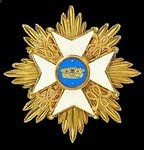Hessen-Darmstadt IR or Prinz Georg Infantry: Upper Rhenish Kreis
On 3rd May 1758 the battalion had a strength of 752 musketeers and 105 grenadiers, a total of 860, with 2 attached 3 pounder cannon.
This small single battalion regiment was reckoned to be the best infantry unit in the Reichsarmee; Soubise called it "excellent" (Duffy, Prussia's Glory), the only regiment he reviewed to be called so. Prince Georg of Hessen-Darmstadt was also reputedly the best general in the Reichsarmee; a former Prussian officer, he had left the Prussian service and joined the Reichsarmee at the command of his father Landgraf Ludwig VIII. For a sympathetic and detailed account of the travails of the Reichsarmee and the doings of the estimable Prince Georg in the 1757 campaign leading up to Rossbach, see Duffy's wonderfully readable Prussia's Glory.
Duffy says that in the Circle of the Upper Rhine (Oberrheinische Creis) "here the lead was taken by the Landgraf Ludwig VIII of Hesse-Darmstadt who was a Protestant, but dedicated to the ideal of the Reich. His single-battalion regiment was the best that the Reichsarmee proper had to show, and represented something of a sacrifice on the part of Ludwig, for he could have hired it out on very favourable terms to a foreign prince. "You can imagine nothing more splendid than the sight of the Darmstadt Grenadiers when they come on guard. They are picked, tall and fine-looking men who put the French to shame"." Despite its high quality the regiment was not immune from the bane of all armies of the period. Duffy later says: "The regiment of Hesse-Darmstadt was the best of the Reichsarmee, yet the secretary of its Prince Georg was happy to record that by 29 July it had lost "only" 116 men from desertion."
At Rossbach on 5th November 1757 the regiment was one of the few to perform well and honourably during the rout of much of the Reichsarmee; it was one of the four regiments which were able to "retreat in closed-up formation under continuous fire" which seem to have been Blue Würzburg, "the disciplined and intact battalion of Hesse-Darmstadt and the Swiss regiment of Wittemer and Diesbach which not only retained all their colours, but retrieved a colour of one of the regiments which had fled." (All quotations from Duffy, Prussia's Glory.)
Later in the war at 1st Torgau (Zinna) on the 8th September 1759 the regiment once again proved its quality: "with the exception of the battalion of Hessen-Darmstadt, the entire Reichs infantry fled in panic." (Duffy, By Force of Arms.) The Reischsarmee force was three times the size of the Prussian force that routed it!
And this was the uniform in 1757:
Mollo and Knötel show 2 different variants of the collar on this uniform, very unlike the normal type of collar shown by Pengel and Hurt, so I've done two variants for those (like me!) who are niggled by these things; P and H's more conventional collar-type is on the left, the one in the middle is Mollo's and the one on the right is Knötel's collar. The Osprey on the Austrian infantry of 1740-1780 also shows the Knötel-style collar.



















